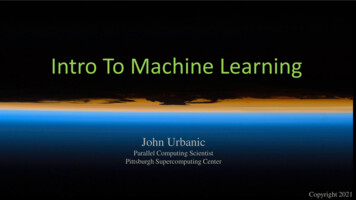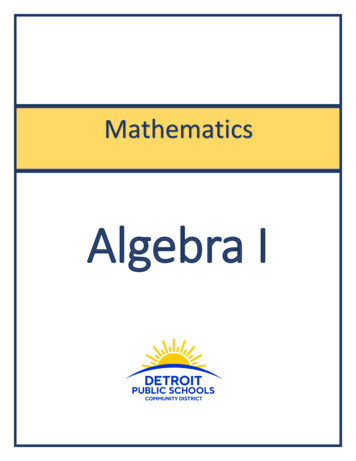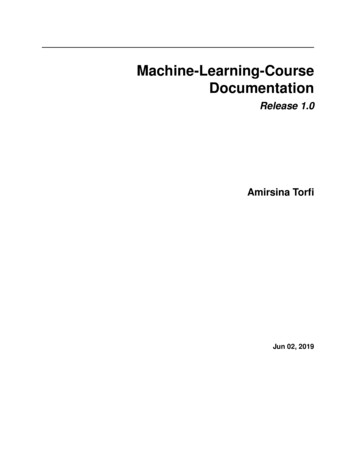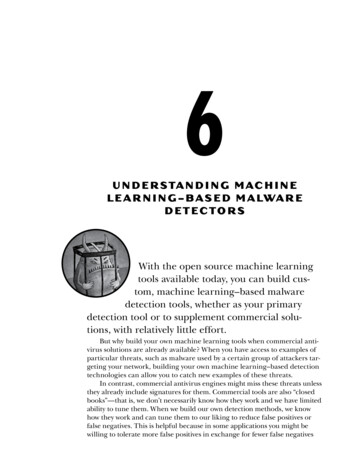
Transcription
Intro To Machine LearningJohn UrbanicParallel Computing ScientistPittsburgh Supercomputing CenterCopyright 2021
Using MLlibOne of the reasons we use spark is for easy access to powerful data analysis tools. The MLlib librarygives us a machine learning library that is easy to use and utilizes the scalability of the Spark system.It has supported APIs for Python (with NumPy), R, Java and Scala.We will use the Python version in a generic manner that looks very similar to any of the aboveimplementations.There are good example documents for the clustering routine we are using, as well as alternativeclustering algorithms, stering.htmlAnd an excellent API reference document nsI suggest you use these pages for all your Spark work.
ClusteringClustering is a very common operation for finding grouping in data and has countless applications. This is a very simpleexample, but you will find yourself reaching for a clustering algorithm frequently in pursuing many diverse machinelearning objectives, sometimes as one part of a pipeline.SizeCoin SortingWeight
ClusteringAs intuitive as clustering is, it presents challenges to implement in an efficient and robust manner.You might think this is trivial to implement in lower dimensional spaces.But it can get tricky even there.Sometimes you know how many clusters you have to start with. Often you don’t.How hard can it be to count clusters? How many are here?We will start with 5000 2D points. We want to figure out how many clusters there are, and their centers. Let’s fire uppyspark and get to it
Finding Clusters/ / / /\ \/ \/ / / ' // / . /\ , / / / /\ \/ /version 1.6.0Using Python version 2.7.5 (default, Nov 20 2015 02:00:19)SparkContext available as sc, HiveContext available as sqlContext. rdd1 sc.textFile("5000 points.txt") rdd2 rdd1.map(lambda x: x.split() ) rdd3 rdd2.map(lambda x: [int(x[0]),int(x[1])] ) br06% interact.r288%r288% module load sparkr288% pysparkRead into RDDTransform to words and integers
Finding Our Way rdd1 sc.textFile("5000 points.txt") rdd1.count()5000 rdd1.take(4)['664159550946', '665845557965', '597173575538', '618600551446'] rdd2 rdd1.map(lambda x:x.split()) rdd2.take(4)[['664159', '550946'], ['665845', '557965'], ['597173', '575538'], ['618600', '551446']] rdd3 rdd2.map(lambda x: [int(x[0]),int(x[1])]) rdd3.take(4)[[664159, 550946], [665845, 557965], [597173, 575538], [618600, 551446]]
Finding Clusters/ / / /\ \/ \/ / / ' // / . /\ , / / / /\ \/ /version 1.6.0Using Python version 2.7.5 (default, Nov 20 2015 02:00:19)SparkContext available as sc, HiveContext available as sqlContext. rdd1 sc.textFile("5000 points.txt") rdd2 rdd1.map(lambda x:x.split()) rdd3 rdd2.map(lambda x: [int(x[0]),int(x[1])]) from pyspark.mllib.clustering import KMeansRead into RDDTransformImport Kmeans
Finding ClustersWhat is theexact answer?
Finding Clusters/ / / /\ \/ \/ / / ' // / . /\ , / / / /\ \/ /version 1.6.0Using Python version 2.7.5 (default, Nov 20 2015 02:00:19)SparkContext available as sc, HiveContext available as sqlContext. rdd1 sc.textFile("5000 points.txt") rdd2 rdd1.map(lambda x:x.split()) rdd3 rdd2.map(lambda x: [int(x[0]),int(x[1])]) from pyspark.mllib.clustering import KMeans for clusters in range(1,30):.model KMeans.train(rdd3, clusters)Let’s see results.print (clusters, model.computeCost(rdd3)).for 1-30 cluster tries1 5.76807041184e 142 3.43183673951e 143 2.23097486536e 144 1.64792608443e 145 1.19410028576e 146 7.97690150116e 137 7.16451594344e 138 4.81469246295e 139 4.23762700793e 1310 3.65230706654e 1311 3.16991867996e 1312 2.94369408304e 1313 2.04031903147e 1314 1.37018893034e 1315 8.91761561687e 1216 1.31833652006e 1317 1.39010717893e 1318 8.22806178508e 1219 8.22513516563e 1220 7.79359299283e 1221 7.79615059172e 1222 7.70001662709e 1223 7.24231610447e 1224 7.21990743993e 1225 7.09395133944e 1226 6.92577789424e 1227 6.53939015776e 1228 6.57782690833e 1229 6.37192522244e 12
Right Answer? for trials in range(10):.print.for clusters in range(12,18):.model KMeans.train(rdd3,clusters).print (clusters, model.computeCost(rdd3))1213141516172.45472346524e 132.00175423869e 131.90313863726e 131.52746006962e 138.67526114029e 128.49571894386e 121213141516172.31466520037e 131.91856542103e 131.49332023312e 131.3506302755e 138.7757678836e 121.60075548613e 131213141516172.62619056924e 132.90031673822e 131.52308079405e 138.91765957989e 128.70736515113e 128.49616440477e 121213141516172.5187054064e 131.83498739266e 131.96076943156e 131.41725666214e 131.41986217172e 138.46755159547e 121213141516172.5524719797e 132.14332949698e 132.11070395905e 131.47792736325e 131.85736955725e 138.42795740134e 121213141516172.38234539188e 131.85101922046e 131.91732620477e 138.91769396968e 128.64876051004e 128.54677681587e 121213141516172.31466242693e 132.10129797745e 131.45400177021e 131.52115329071e 131.41347332901e 131.31314086577e 131213141516172.5187054064e 132.04031903147e 131.95213876047e 131.93000628589e 132.07670831868e 138.47797102908e 121213141516172.47927778784e 132.43404436887e 132.1522702068e 138.91765000665e 121.4580927737e 138.57823507015e 121213141516172.39830397362e 132.00248378195e 131.34867337672e 132.09299321238e 131.32266735736e 138.50857884943e 12
Find the Centers for trials in range(10):#Try ten times to find best result.for clusters in range(12, 16):#Only look in interesting range.model KMeans.train(rdd3, clusters).cost model.computeCost(rdd3).centers model.clusterCenters#Let’s grab cluster centers.if cost 1e 13:#If result is good, print it out.print (clusters, cost).for coords in centers:.print (int(coords[0]), int(coords[1])).break.15 8.91761561687e 12852058 157685606574 574455320602 161521139395 558143858947 546259337264 562123244654 847642398870 404924670929 862765823421 731145507818 175610801616 321123617926 399415417799 787001167856 34781215 8.91765957989e 12670929 862765139395 558143244654 847642852058 157685617601 399504801616 321123507818 175610337264 562123858947 546259823421 731145606574 574455167856 347812398555 404855417799 787001320602 161521
00000
16 001000000
Dimensionality ReductionWe are going to find a recurring theme throughout machine learning: Our data naturally resides in higher dimensions Reducing the dimensionality makes the problem more tractable And simultaneously provides us with insightThis last two bullets highlight the principle that "learning" is often finding an effective compressedrepresentation.As we return to this theme, we will highlight these slides with our DimensionalityReduction badge so that you can follow this thread and appreciate how fundamentalit is.
Why all these dimensions?The problems we are going to address, as well as the ones you are likely to encounter, are naturally highlydimensional. If you are new to this concept, lets look at an intuitive example to make it less abstract.Purchase Total ( )Children's Clothing 800Pet Supplies 0Cameras (Dash, Security, Baby) 450Containers (Storage) 350Romance Book 0Remodeling Books 80Sporting Goods 25Children's Toys 378Power Tools 0Computers 0Garden 0Children's Books 180.This is a 2900 dimensionalvector. 2900 Categories Category
Why all these dimensions?If we apply our newfound clustering expertise, we might find we have 80 clusters (with an acceptableerror).People spending on “child’s toys “ and “children’s clothing” might cluster with “child’s books” and, lessobvious, "cameras (Dashcams, baby monitors and security cams)", because they buy new cars and aresafety conscious. We might label this cluster "Young Parents". We also might not feel obligated to label theclusters at all. We can now represent any customer by their distance from these 80 clusters.80 dimensional vector.Customer oEnthusiastKnitterSteelers FanShakespeareReaderSci-Fi FanPlumber.Distance0.022.31.48.42.214.93.30.8.We have now accomplished two things: we have compressed our data learned something about our customers (who to send a dashcam promo to).
Curse of DimensionalityThis is a good time to point out how our intuition can lead us astray as we increase the dimensionality of our problems - which we willcertainly be doing - and to a great degree. There are several related aspects to this phenomenon, often referred to as the Curse ofDimensionality. One root cause of confusion is that our notion of Euclidian distance starts to fail in higher dimensions.These plots show the distributions of pairwise distancesbetween randomly distributed points within differentlydimensioned unit hypercubes. Notice how all the points startto be about the same distance apart.Once can imagine this makes life harder on a clusteringalgorithm!There are other surprising effects: random vectors arealmost all orthogonal; the unit sphere takes almost novolume in the unit square. These cause all kinds of problemswhen generalizing algorithms from our lowly 3D world.
MetricsEven the definition of distance (the metric) can vary based upon application. If you are solving chess problems, you might find theManhattan distance (or taxicab metric) to be most useful.Image Source: WikipediaFor comparing text strings, we might choose one of dozens of different metrics. For spell checking you might want one that isgood for phonetic distance, or maybe edit distance. For natural language processing (NLP), you probably care more about tokens.For genomics, you might care more about string sequences.Some useful measures don't even qualify as metrics (usually because they fail the triangle inequality: a b c ).
Alternative DR: Principal Component Analysis3D Data SetMaybe mostly 1D!
Alternative DR: Principal Component AnalysisFlatter 2D-ish Data SetView down the 1st Princ. Comp.
Why So Many Alternatives?Let's look at one more example today. Suppose we are tying to do a Zillow type of analysis and predict home values based upon availablefactors. We may have an entry (vector) for each home that captures this kind of data:Home DataLatitude4833438 northLongitude630084 eastLast Sale Price 480,000Last Sale rage2Yard Width84Yard Depth60.There may be some opportunities to reduce the dimension of the vector here. Perhaps clustering on the geographical coordinates.
Principal Component Analysis FailNon-Linear PCA?A Better Approach Tomorrow!1st Component OffD x W Is Not LinearData Not Very LinearBut (DxW) Fits Well
Why Would An Image Have 784 Dimensions?MNIST 28x28greyscale images
Central Hypothesis of Modern DL9207637891Data Lives OnA Lower DimensionalManifold5344Maybe Less SoMaybe Very ContiguousImages from Wikipedia
Testing These Ideas With Scikit-learnimport numpy as npimport matplotlib.pyplot as pltfrom sklearn import (datasets, decomposition, manifold, random projection)def draw(X, ]); plt.ylim(X.min(0)[1],X.max(0)[1])plt.xticks([]); plt.yticks([])plt.title(title)for i in range(X.shape[0]):plt.text(X[i, 0], X[i, 1], str(y[i]), color plt.cm.Set1(y[i] / 10.) )digits datasets.load digits(n class 6)X digits.datay digits.targetrp random projection.SparseRandomProjection(n components 2, random state 42)X projected rp.fit transform(X)draw(X projected, "Sparse Random Projection of the digits")X pca decomposition.PCA(n components 2).fit transform(X)draw(X pca, "PCA (Two Components)")tsne manifold.TSNE(n components 2, init 'pca', random state 0)X tsne tsne.fit transform(X)draw(X tsne, "t-SNE Embedding")plt.show()Sparse
How does all this fit together?BigDataCharacter RecognitionCapchasChessCharacter RecognitionCapchasChessDLnee Neural NetsGoDLMLAIGo
TheJourneyAhead
gives us a machine learning library that is easy to use and utilizes the scalability of the Spark system. It has supported APIs for Python (with NumPy), R, Java and Scala. We will use the Python version in a generic manner tha










